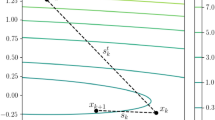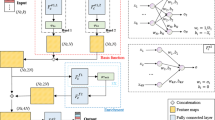Abstract
Machine learning has been widely used for solving partial differential equations (PDEs) in recent years, among which the random feature method (RFM) exhibits spectral accuracy and can compete with traditional solvers in terms of both accuracy and efficiency. Potentially, the optimization problem in the RFM is more difficult to solve than those that arise in traditional methods. Unlike the broader machine-learning research, which frequently targets tasks within the low-precision regime, our study focuses on the high-precision regime crucial for solving PDEs. In this work, we study this problem from the following aspects: (i) we analyze the coefficient matrix that arises in the RFM by studying the distribution of singular values; (ii) we investigate whether the continuous training causes the overfitting issue; (iii) we test direct and iterative methods as well as randomized methods for solving the optimization problem. Based on these results, we find that direct methods are superior to other methods if memory is not an issue, while iterative methods typically have low accuracy and can be improved by preconditioning to some extent.











Similar content being viewed by others
References
Alaoui, A., Mahoney, M.W.: Fast randomized kernel ridge regression with statistical guarantees. In: advances in neural information processing systems, vol. 28, pp. 775–783. Curran Associates Inc., New York (2015)
Amestoy, P.R., Duff, I.S., Koster, J., L’Excellent, J.-Y.: A fully asynchronous multifrontal solver using distributed dynamic scheduling. SIAM J. Matrix Anal. Appl. 23(1), 15–41 (2001)
Anderson, E., Bai, Z., Bischof, C., et al.: LAPACK Users’ Guide. SIAM, Philadelphia (1995)
Avron, H., Maymounkov, P., Toledo, S.: Blendenpik: supercharging LAPACK’s least-squares solver. SIAM J. Sci. Comput. 32(3), 1217–1236 (2010)
Bach, F.: Sharp analysis of low-rank kernel matrix approximations. In: Proceedings of the 26th Annual Conference on Learning Theory, PMLR, pp. 185–209 (2013)
Balay, S., Gropp, W., McInnes, L.C., Smith, B.F.: PETSc: the portable, extensible toolkit for scientific computation. Argonne National Laboratory, vol. 2, no. 17 (1998)
Barron, A.R.: Universal approximation bounds for superpositions of a sigmoidal function. IEEE Trans. Inf. Theory 39(3), 930–945 (1993)
Belkin, M., Hsu, D., Ma, S., Mandal, S.: Reconciling modern machine-learning practice and the classical bias-variance trade-off. Proc. Natl. Acad. Sci. USA 116(32), 15849–15854 (2019)
Blackford, L.S., Demmel, J., Dongarra, J., Duff, I., Hammarling, S., Henry, G., Heroux, M., Kaufman, L., Lumsdaine, A., Petitet, A., Pozo, R., Remington, K., Whaley, R.C. An updated set of basic linear algebra subprograms (BLAS). ACM Trans. Math. Softw. 28(2), 135–151 (2002)
Bollhöfer, M., Schenk, O., Janalik, R., Hamm, S., Gullapalli, K.: State-of-the-art sparse direct solvers. In: Grama, A., Sameh, A. (eds) Parallel Algorithms in Computational Science and Engineering. Modeling and Simulation in Science, Engineering and Technology. pp. 3–33. Birkhäuser, Cham (2020)
Calabrò, F., Fabiani, G., Siettos, C.: Extreme learning machine collocation for the numerical solution of elliptic PDEs with sharp gradients. Comput. Methods Appl. Mech. Eng. 387(1), 114–188 (2021)
Chandra, R., Dagum, L., Kohr, D., Menon, R., Maydan, D., McDonald, J.: Parallel Programming in OpenMP. Morgan Kaufmann, Burlington (2001)
Chen, J., Chi, X., E, W.: Bridging traditional and machine learning-based algorithms for solving PDEs: the random feature method. J. Mach. Learn. 1(3), 268–298 (2022)
Chen, Z., Schaeffer, H.: Conditioning of random feature matrices: double descent and generalization error. arXiv:2110.11477 (2021)
Cybenko, G.V.: Approximation by superpositions of a sigmoidal function. Math. Control Signals Syst. 2(4), 303–314 (1989)
Davis, T.A.: Direct Methods for Sparse Linear Systems. Fundamentals of Algorithms. SIAM, Philadelphia (2006)
Davis, T.A.: Algorithm 915, SuiteSparseQR: multifrontal multithreaded rank-revealing sparse QR factorization. ACM Trans. Math. Softw. 38(1), 8 (2011)
Dong, S., Li, Z.: Local extreme learning machines and domain decomposition for solving linear and nonlinear partial differential equations. Comput. Methods Appl. Mech. Eng. 387(1), 114–129 (2021)
Drineas, P., Kannan, R., Mahoney, M.W.: Fast Monte Carlo algorithms for matrices II: computing a low-rank approximation to a matrix. SIAM J. Comput. 36(1), 158–183 (2006)
E, W., Bing, Y.: The deep Ritz method: a deep learning-based numerical algorithm for solving variational problems. Commun. Math. Stat. 6(1), 1–12 (2018)
E, W., Han, J., Jentzen, A.: Deep learning-based numerical methods for high-dimensional parabolic partial differential equations and backward stochastic differential equations. Commun. Math. Stat. 5(4), 349–380 (2017)
E, W., Wang, Q.: Exponential convergence of the deep neural network approximation for analytic functions. Sci. China Math. 61(10), 1733–1740 (2018)
Elmroth, E., Gustavson, F.G.: Applying recursion to serial and parallel QR factorization leads to better performance. IBM J. Res. Dev. 44(4), 605–624 (2000)
Falgout, R.D., Yang, U.M.: hypre: A library of high performance preconditioners. In: Sloot, P.M.A., Hoekstra, A.G., Tan, C.J.K., Dongarra, J.J. (eds) Computational Science—ICCS 2002. ICCS 2002. Lecture Notes in Computer Science, vol. 2331, pp. 632–641. Springer, Berlin, Heidelberg (2002)
Fong, D.C.-L., Saunders, M.: LSMR: an iterative algorithm for sparse least-squares problems. SIAM J. Sci. Comput. 33(5), 2950–2971 (2011)
Golub, G.H., Van Loan, C.F.: Matrix Computations, 4th edn. Johns Hopkins Studies in the Mathematical Sciences, vol. 3. Johns Hopkins University Press, Baltimore (2013)
Gould, N., Scott, J.: The state-of-the-art of preconditioners for sparse linear least-squares problems. ACM Trans. Math. Softw. 43(4), 1–35 (2017)
Guennebaud, G., et al.: Eigen v3. http://eigen.tuxfamily.org (2010)
Halko, N., Martinsson, P.-G., Tropp, J.A.: Finding structure with randomness: probabilistic algorithms for constructing approximate matrix decompositions. SIAM Rev. 53(2), 217–288 (2011)
Han, J., Jentzen, A., E, W.: Solving high-dimensional partial differential equations using deep learning. Proc. Natl. Acad. Sci. USA 115(34), 8505–8510 (2018)
Hénon, P., Ramet, P., Roman, J.: PaStiX: a high-performance parallel direct solver for sparse symmetric positive definite systems. Parallel Comput. 28, 301–321 (2002)
Hestenes, M.R., Stiefel, E.: Methods of conjugate gradients for solving linear systems. J. Res. Nat. Bur. Stand. 49(6), 409 (1952)
Huang, G.-B., Zhu, Q.-Y., Siew, C.-K.: Extreme learning machine: theory and applications. Neurocomputing 70(1), 489–501 (2006)
IEEE Standard for Floating-Point Arithmetic, IEEE Std 754-2019 (Revision of IEEE 754-2008), 1–84 (2019)
Karczmarz, S.: Angenäherte auflösung von systemen linearer gleichungen. Bull. Int. Acad. Pol. Sci. Lett. 35, 355–357 (1937)
Kingma, D.P., Ba, J.: Adam: a method for stochastic optimization. CoRR preprint. arXiv:1412.6980 (2014)
Lehoucq, R.B., Sorensen, D.C., Yang, C.: RPACK users’ guide—solution of large-scale eigenvalue problems with implicitly restarted Arnoldi methods. Software, environments, tools (1998)
LeVeque, R.J.: Finite Difference Methods for Ordinary and Partial Differential Equations: Steady-State and Time-Dependent Problems. SIAM, Philadelphia (2007)
Li, X.S.: An overview of superlu: algorithms, implementation, and user interface. ACM Trans. Math. Softw. 31, 302–325 (2003)
Luo, T., Yang, H.: Two-layer neural networks for partial differential equations: optimization and generalization theory. arXiv:2006.15733 (2020)
Neal, R.M.: Bayesian learning for neural networks. Ph.D. thesis, University of Toronto, Toronto (1995)
Nguyen, V.P., Rabczuk, T., Bordas, S., Duflot, M.: Meshless methods: a review and computer implementation aspects. Math. Comput. Simul. 79(3), 763–813 (2008)
Nocedal, J., Wright, S.J., Optimization, N.: Springer Series in Operations Research and Financial Engineering. Springer, New York (2006)
Owhadi, H., Zhang, L.: Metric-based upscaling. Commun. Pure Appl. Math. 60(5), 675–723 (2007)
Paige, C.C., Saunders, M.A.: LSQR: an algorithm for sparse linear equations and sparse least squares. ACM Trans. Math. Softw. 8(1), 43–71 (1982)
Polak, E.: Introduction to linear and nonlinear programming. IEEE Trans. Autom. Control 19(3), 290–290 (1974)
Rahaman, N., Baratin, A., Arpit, D., Dräxler, F., Lin, M., Hamprecht, F.A., Bengio, Y., Courville, A.C.: On the spectral bias of neural networks. In: International Conference on Machine Learning (2018)
Rahimi, A., Recht, B.: Random features for large-scale kernel machines. In: Advances in Neural Information Processing Systems (NIPS), vol. 20. Curran Associates Inc. (2007)
Raissi, M., Perdikaris, P., Karniadakis, G.E.: Physics-informed neural networks: a deep learning framework for solving forward and inverse problems involving nonlinear partial differential equations. J. Comput. Phys. 378, 686–707 (2019)
Ruder, S.: An overview of gradient descent optimization algorithms. CoRR preprint. arXiv:1609.04747 (2016)
Rudi, A., Camoriano, R., Rosasco, L.: Less is more: Nyström computational regularization. In: Proceedings of the 28th International Conference on Neural Information Processing Systems, vol. 1, pp. 1657–1665. MIT Press, Cambridge (2015)
Saad, Y.: Iterative Methods for Sparse Linear Systems, 2nd edn. SIAM (2003)
Shen, J., Tang, T., Wang, L.-L.: Spectral Methods: Algorithms, Analysis and Applications, vol. 41. Springer Science & Business Media, New York (2011)
Sirignano, J.A., Spiliopoulos, K.: DGM: a deep learning algorithm for solving partial differential equations. J. Comput. Phys. 375, 1339–1364 (2018)
Sutherland, D.J., Schneider, J.: On the error of random Fourier features. In: Proceedings of the Thirty-First Conference on Uncertainty in Artificial Intelligence (Arlington, Virginia, USA), UAI’15. pp. 862–871. AUAI Press (2015)
The Trilinos Project Team. The Trilinos Project Website (2023). https://trilinos.github.io
Virtanen, P., Gommers, R., Oliphant, T.E., Haberland, M., Reddy, T., Cournapeau, D., Burovski, E., Peterson, P., Weckesser, W., Bright, J., van der Walt, S.J., Brett, M., Wilson, J., Millman, K.J., Mayorov, N., Nelson, A.R.J., Jones, E., Kern, R., Larson, E., Carey, C.J., Polat, İ, Feng, Y., Moore, E.W., VanderPlas, J., Laxalde, D., Perktold, J., Cimrman, R., Henriksen, I., Quintero, E.A., Harris, C.R., Archibald, A.M., Ribeiro, A.H., Pedregosa, F., van Mulbregt, P., SciPy 1.0 Contributors: SciPy 1.0: fundamental algorithms for scientific computing in Python. Nat. Methods 17, 261–272 (2020)
Williams, C., Seeger, M.: Using the Nyström method to speed up kernel machines. In: Advances in Neural Information Processing Systems, vol. 13. MIT Press, Cambridge (2000)
Xu, Z.-Q.J.: Frequency principle: Fourier analysis sheds light on deep neural networks. Commun. Comput. Phys. 28(5), 1746–1767 (2020)
Yang, Y., Hou, M., Luo, J.: A novel improved extreme learning machine algorithm in solving ordinary differential equations by Legendre neural network methods. Adv. Difference Equ. 2018(1), 1–24 (2018)
Zang, Y., Bao, G., Ye, X., Zhou, H.: Weak adversarial networks for high-dimensional partial differential equations. J. Comput. Phys. 411, 109409 (2020)
Zhang, X., Wang, Q., Zhang, Y.: Model-driven level 3 BLAS performance optimization on Loongson 3a processor. In: 2012 IEEE 18th International Conference on Parallel and Distributed Systems, pp. 684–691 (2012)
Zienkiewicz, O.C., Taylor, R.L., Zhu, J.Z.: The Finite Element Method: Its Basis and Fundamentals. Elsevier, Amsterdam (2005)
Zouzias, A., Freris, N.M.: Randomized extended Kaczmarz for solving least squares. SIAM J. Matrix Anal. Appl. 34(2), 773–793 (2013)
Acknowledgements
The work is supported by the NSFC Major Research Plan—Interpretable and General-purpose Next-generation Artificial Intelligence (No. 92370205).
Author information
Authors and Affiliations
Corresponding author
Ethics declarations
Conflict of Interest
On behalf of all the authors, the corresponding author states that there is no conflict of interest.
Additional information
Dedicated to Professor Stanley Osher on the occasion of his 80th birthday.
Rights and permissions
Springer Nature or its licensor (e.g. a society or other partner) holds exclusive rights to this article under a publishing agreement with the author(s) or other rightsholder(s); author self-archiving of the accepted manuscript version of this article is solely governed by the terms of such publishing agreement and applicable law.
About this article
Cite this article
Chen, J., E, W. & Sun, Y. Optimization of Random Feature Method in the High-Precision Regime. Commun. Appl. Math. Comput. (2024). https://doi.org/10.1007/s42967-024-00389-8
Received:
Revised:
Accepted:
Published:
DOI: https://doi.org/10.1007/s42967-024-00389-8
Keywords
- Random feature method (RFM)
- Partial differential equation (PDE)
- Least-squares problem
- Direct method
- Iterative method




